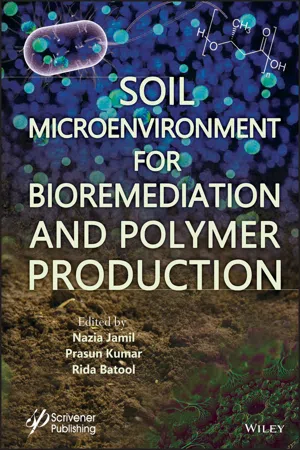Chapter 1
Applications of Microorganisms in Agriculture for Nutrients Availability
Fehmida Fasim1* and Bushra Uziar2
1Discipline of Biomedical Science, Sydney Medical School, University of Sydney, Australia
2International Islamic University, Department of Bioinformatics and Biotechnology, Islamabad Capital Territory, Islamabad
Abstract
Constantly increasing global food demand, over use of Phosphorus (P) containing fertilisers to improve agricultural productivity not only causes pollution of ground and surface water but also depletes soil fertility and leads to accumulation of toxic elements in the soil. Production of healthy agriculture crops is essentially dependant on the available nutrients in soil. In healthy crop production, key nutrients such as phosphorus (P), iron (Fe), nitrogen (N) and potassium (K) play a major role. Chemical fertilizers are in great demand as most soils are deficient in key nutrients. Hence efforts are made for an innovative, alternative and environmentally friendly techniques over conventional chemical fertilizers. Microbes play a pivotal role in increasing the nutrients bioavailability such as mobilization of major nutrients and nitrogen fixation that improve the plant yield and growth. In this review, current findings on the mechanisms utilized by various microbes will be discussed and highlighted. Furthermore, in improving soil fertility the inoculation of microbes in various forms such as sole inoculation, co-inoculation or in combination with organic fertilizer will be debated.
Keywords: Soil depletion, soil microbes, solubilization, co-inoculation, biofertilizer
1.1 Introduction
In developing countries from 1970 to 1995, the global food production had increased by 70% mainly because of new technology called conventional agriculture which was based on chemical fertilizers, synthetic pesticides and irrigation to produce high yields [1, 2]. The use of such technologies are destroying the natural environment in many ways such as surface and ground water contamination, increased pest resistance, soil erosion and reduced biodiversity [3, 4]. Keeping in mind the increasing population and food demand worldwide, sustainable methods are key for food production. To avoid mitigating climate change and land degradation the sustainable methods must sustain this natural resource. This can be done by fine tuning of current technologies or to develop alternate technologies without damaging the environment or natural resources to obtain high yield crops that can meet food demand globally.
About organic and inorganic fertilizers there are numerous myths [5, 6]. Without enough scientific evidence, it appears that mostly these myths are based on conjunctions, perceptions, or for political motives. Regarding chemical fertilizers some legends are listed below:
1.1.1 Land and Soil Deterioration
Soil’s physical and chemical properties are destroyed by chemical fertilizers whereas fertility is improved by organic fertilizers [5]. Soil structure by chemical fertilisers is not affected if it is administered in the right quantity. Nitrogen (N) fertilizers tend to acidify soil to a pH of < 5 which can have adverse effects. If administered at an optimal dose it may positively influence soil biota. If applied in high amount then it may alter soil texture, reduce in microbial community and increase soil acidification.
1.1.2 Micro-Nutrients Lacks
Regarding chemical fertilizers there is a popular misconception that macro-nutrients are in low amounts when in fact they are lacking. Organic fertilizers generally contain some micro-nutrients however there are some inorganic fertilizers containing micro-nutrients commercially available too [5].
Adoption of Integrated Soil Fertility management can help restore fertility of soil as explained by Vlek and Vielhauer [7]. This involves a strategy that allows for control of soil nutrients, nitrogen fixation and efficiency in administration.
This strategy encompasses use of biofertilizers which are biocompatible and economically viable plant nutrients to help supplement synthetic fertilisers for a more sustainable agricultural system. The aim is to increase production and sustain balance of the nutrients in soil.
1.2 Biofertilizers
Microbial inoculants or biofertilizers are live or latent cell of strains that are efficient in phosphate solubilization, nitrogen fixation, potassium solubilization, siderophore production used for seed application, soil or composting areas where such microorganism population can increase and enhance several microbial processes to boost the nutrients availability that can be utilised by plants. The history of applying microbial inoculums have passed down generations of farmers. The efficacy of biofertilizers was evident when on small scale culture compost was introduced, it enhanced the decomposition of organic residues and agriculture by-products that resulted in healthy harvest of crops [8].
In biofertilizer making several things are considered such as growth profile of the selected microbe, organism’s optimum conditions and inoculum formulation. For the success of biological product critical steps are inocula formulation, application method and product storage.
Generally, six key steps are required in making a biofertilizer, 1) organism selection, 2) solation, 3) method selection and carrier material, 4) propagation method selection, 5) prototype testing and 6) large scale testing. In late 1940’s, Malaysia started using industrial scale microbial inoculants and took guide by Brady rhizobium on legumes topped up in 1970’s. Malaysian Rubber Board (MRB), a government research institute has conducted research on Rhizobium inoculums for use on leguminous cover crops of young rubber trees in the large-scale plantations. Since 1980 many research projects on Mycorrhiza were conducted at University Putra Malaysia (UPM) and led to Azospirillum nitrogen to oil palm seedlings [8].
1.3 Rhizosphere
Root network is surrounded by a narrow zone of soil termed as rhizosphere [9], and the bacteria that colonises in the root environment are termed ‘rhizobacteria’ [10]. These roots not only provide mechanical support, nutrient uptake and facilitate water but also synthesize various compounds [9]. Heterogeneous, multifaceted and active microbial communities are attracted to the compounds produced by roots. In a nutshell they act as chemical attractants commonly called as root e...
